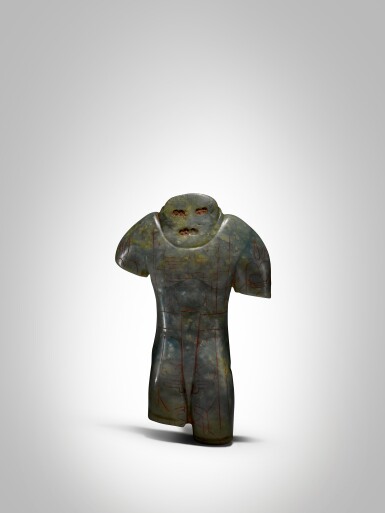Art of Africa, Oceania, and the Americas
Art of Africa, Oceania, and the Americas

Property from an American Private Collection
Olmec Jade Incised Torso, Middle Preclassic, circa 900-600 BC
Lot Closed
November 21, 07:19 PM GMT
Estimate
25,000 - 35,000 USD
Lot Details
Description
Property from an American Private Collection
Olmec Jade Incised Torso
Middle Preclassic, circa 900-600 BC
Height: 3 ⅜ in (8.6 cm)
Private Collection
American Private Collection, acquired from the above in 1981
Michael D. Coe, ed. The Olmec World: Ritual and Rulership, Princeton, 1995, p. 152, cat. no. 23
Karl A. Taube, Olmec Art at Dumbarton Oaks, Washington, D.C., 2004, p. 76, fig. 34f (drawing)
The prized blue-green color of the jade, delicately incised motifs, and the refined physiognomy of the figure led to its valued repurposing as an heirloom. It is a figure whereby the incised motifs brand it as a central axis of power connected to the potent supernaturals of the Olmec world.
The figure has a slender waist with broad shoulders that gently narrow and are flexed backward in a ceremonial posture. The curve of the legs indicates a relaxed bend to the once-present lower legs. The figure's broken limbs were smoothed and repolished and the left arm was drilled for attachment of a lower arm. In an effort to complete the figure, a minimal face was drilled into the neck.
Important Olmec iconography is expertly incised over the torso, legs, and upper arms, marking the figure as a conduit and carrier of power. The iconography is centered on the image of the Olmec Dragon and vegetative elements. The chest is incised with the frontal face of the Supernatural that is framed within double bands running vertically the length of the body and legs. The waistband is carved to cover this framing device implying the motifs were on the body of the figure and the waistband thus covers the image. A large looped knot of the loincloth is incised on the back. The shoulders are each incised with sprouting cleft elements of maize and the upper legs appear to bisect a symmetrical frontal face.
For a figure of similar form, see Michael D. Coe, ed. The Olmec World: Ritual and Rulership, Princeton, 1995, p. 149, cat. no. 19; for a similar incised jade heirloom figure see Sotheby's, New York, May 17, 2000, lot 92. See also Elizabeth P. Benson and Beatriz de la Fuente, eds., Olmec Art of Ancient Mexico, Washington, 1996, p. 207, cat. no. 46, for a recarved jade figure.
Please note
